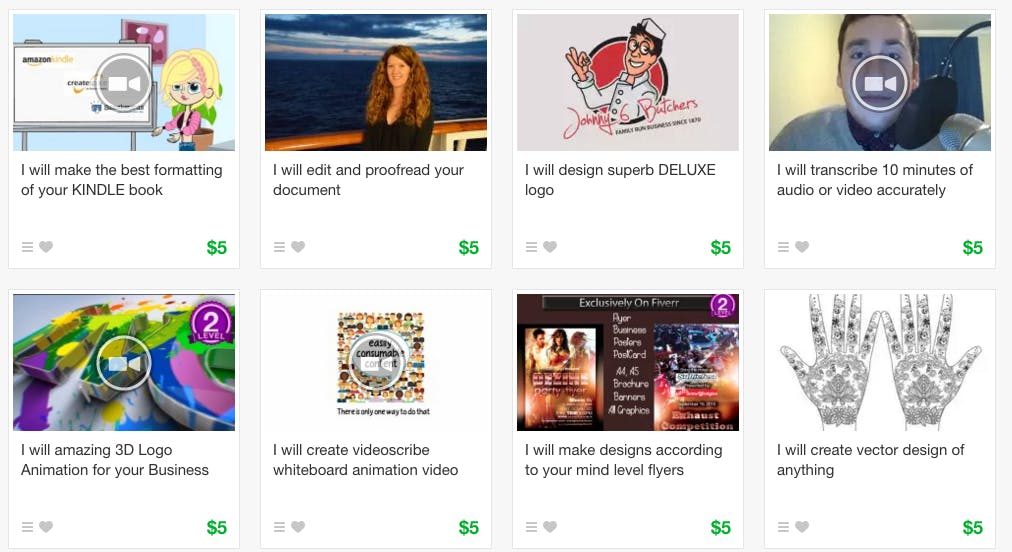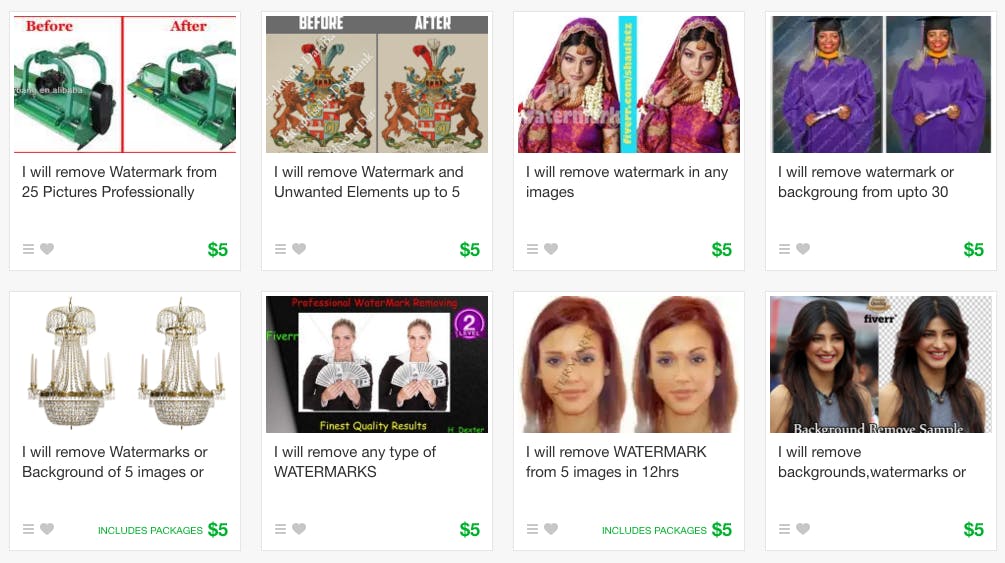To paraphrase Adam Smith, consumers choose for the lowest price, while entrepreneurs choose for the highest rate of profit. This balance in a capitalistic society is what gives us “healthy competition,” the metaphor of the invisible hand, and other aspects of what many assume inspires a robust economy. It’s what much of the gig economy is based on—the idea that if you make “employees” into “contractors” or “giggers,” consumers can find more services for less.
Sites like Fiverr, FiverUp, and Gigbucks offer professional creative services for as low as $5. But—spoiler alert—many artists are worried they’re setting the floor too low.
If you haven’t seen Fiverr’s ads on Facebook, you will soon. The site offers design work, custom illustrations, copywriting, and many other creative services for the low, low price of $5. At least, that’s the starting point. According to Aimy Ngo, the business development strategist for Fiverr, the six-year-old site has recently “opened up pricing, so someone on the site can price their gig anywhere from $5 to $995.” Indeed, most sellers seem to have upgrades and pricier packages advertised on their pages. A black-and-white illustration may cost $5, but color, shading, revisions, or a variety of files cost extra.
But Fiverr’s language still centers its services around that lowest price. Fiverr does not advertise itself as the largest marketplace for professional creative freelance services: It’s “the world’s largest marketplace for services starting at $5.” On its FAQ page, it states that “all Gigs start at $5 and some contain extra services, which you can purchase as well.” Fiverr’s ads frequently say things like “Get the job done for $5.”
Gig sites are not the only thing making people think they can get good art and design for cheap. But Fiverr’s messaging is disconcerting to many freelancers who worry its message devalues what they do.
“There’s two sides to pricing,” says cartoonist Tony Breed. “There’s what will the market pay, and there’s what’s my time, experience, and skill worth.”
“Unless I could only offer things produced in 10 minutes or less without revisions and no material cost, it’s just not worth my time,” adds Roberto Gato Echanique, an artist and designer living in Maryland. Breed says the lowest price he’s seen offered for a simple, black-and-white avatar among his peers is $30, still six times what’s often offered on gig sites.
Most artists and designers find a way to be flexible with those rates depending on both the skill and time needed for the project, and the budget of the potential client. But the price point they’re negotiating from is far higher than the one sites like Fiverr have set as a baseline. “The thing that makes me angry is that I go into Facebook and I get these ads that say, ‘Hey! Someone is doing what you do for $5,’” Breed says.
Breed has a full-time job and does cartooning and illustration work on the side. But even though illustration work isn’t his primary source of income, there’s no way $5 or $10 would be enough for him to do the job he sees offered on gig websites. “I can’t imagine that anyone is worth $5. I wonder, what is the quality that you’re getting? I might have done that in high school, but not now.”
“Fiverr basically says, the only thing that matters is cost,” says Christian Brown, a freelance graphic designer and animator. “To hit a minimum wage, you’d have to do two an hour, all day.” And that’s just minimum wage, which is not exactly the same as a living wage.
According to Fiverr’s Ngo, that’s why the company opened pricing. “Freelancers should be able to value their work at what they think it is worth. And everyone knows there’s a difference between a logo that gets made for $5 and one that gets made for $200,” she says.
But Brown says it doesn’t matter how high the prices can go. “Even if they know they’d get a bad product from a cheap site, it’s still lowering the cost floor.”
Most artists I spoke to seemed confused at just who these artists are who offer their services for so low, but there are “hundreds of thousands of sellers” on Fiverr, says Ngo, and in 190 countries. And many of them are doing well.
Anthony Vincent, for example, used Fiverr to launch his own custom songs business and ultimately catapult him to YouTube fame. His Ten Second Songs have since clocked over 90 million views.
Recently, freelance writer Danielle Corcione wrote about her experiences with Fiverr for the Billfold. From the beginning she was told that working for gig sites would not be good for her career, and that “working for little to no pay brings down the worth of the freelance writing community as a whole.” But by offering services she wouldn’t offer in traditional freelance spaces (like writing social media bios and editing resumes), and offering add-ons to services, she is able to support herself. “I profited from a site that otherwise recruits writers towards cheap labor,” she wrote.
Cassie Peng is a freelance artist from China who now lives in the U.K. She received a master’s degree in art and design in 2011, and joined Fiverr when she graduated to try to support herself. “It was only spare money to support my life, but soon, within three months, I made myself a top-rated seller on Fiverr.” She started by selling $5 drawings, which after a few months of practice, she says she was able to bang out in 10–15 minutes. Soon, clients started paying for more premium packages, and, according to Peng, she made over $100,000 from the site last year.
Jessie Tran, a student in Canada, looked to Fiverr to help expand her portfolio and experiment with her art while making a little money. “I have to admit that was difficult” working for $5 per comic page, she said, “but in time when you get better and you have a lot of positive reviews, you can raise the price up and people still come for your service. Everyone has to start somewhere.”
When asked if she was worried that charging $5 for work was undercutting the rates of fellow freelancers, Tran says she used to think so, but “I changed my opinion lately. Sites like Fiverr encourage not only amateur artists, but also self-employed people. … If you are really good at what you do, people will come to you for the best quality product. And I believe that every artist knows their worth and adjusts the price accordingly.”
Peng agrees, saying that gig services only take over the lower end of the market, while people who have the money will go for the higher end. “Fiverr is for the people who can’t afford to pay for an expensive service; the people who can afford to pay will still go to a proper design company for their work.”
One of the reasons prices can be so low on Fiverr is because there’s very little oversight involved. “I’ve heard stories of artists who had logos get ripped off by people on gig sites like Fiverr, who’d just swap the company name and move on,” says Brown. “Likewise, there’s a lot of people who take a free project file and swap out a company name.”
There’s no shortage of sellers advertising these shady services up front. For example, here’s what happens when you type “remove watermark” into the search bar of Fiverr:
Ngo says Fiverr takes seriously any complaints from buyers about being ripped off from sellers, both by addressing those allegations directly and by educating buyers about the kinds of things they’re paying for at each price point. At $5 or $10 for a logo, Ngo explains, “it could be a template logo that is a royalty through license, so it’s not custom-made,” whereas a $200 logo is more likely to be custom and have exclusive license.
Whether or not it’s actually attained, transparency is the goal on gig sites—presumably you know exactly what you’re paying for. And for creative work, that can be attractive. Many freelancers don’t post their rates publicly, because their rates depend on a lot of factors and they’re often willing to work with clients. However, not a lot of clients know that, so seeing a flat rate of $20 for exactly the package you want is enticing. This allows gig sites to dominate expectations for how much services should go for. If the only price you see is a low price, it becomes the norm.
“It’s a bit philosophical to talk about what an artist’s work or time is ‘worth,’ as though it were an objective fact,” says Zoe Piel, a freelance illustrator and designer. “What is anything worth? It’s worth only and exactly what the buyer and seller agree to exchange it for. That agreement is personal, it’s cultural, it’s regional, it’s historical.” And we all seem to be agreeing that $5 is fine for anything. No one bats an eye at paying $5 for an H&M T-shirt or a Subway sandwich anymore, so why should an hour of copywriting work or an illustrated avatar be any different? Sites like Fiverr did not invent these ideas, but they’re not doing much to stop them. For that, people need to learn that the upgrades are worth it.
Correction: An earlier version of this story misspelled the name of Aimy Ngo, business development strategist for Fiverr.
Photo via Xuan Che/Flickr (CC BY 2.0)





